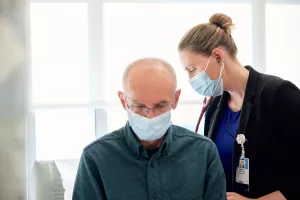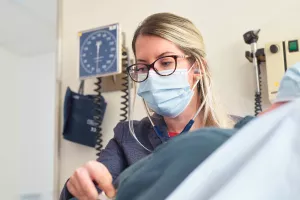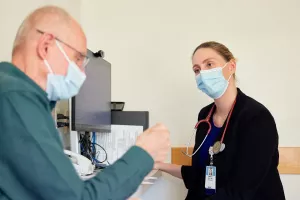Aortic diseases are a group of conditions that affect your aorta. As your body’s largest artery, the aorta carries blood away from your heart and pumps it throughout the rest of your body. These diseases can take different forms, with aortic aneurysms being the most common.
Here for you and your heart
We treat thousands of people living with an aortic disease each year. We’ll be with you from day 1, whether that’s the day of your diagnosis or the day of your first preventive care visit.
Aortic diseases affect the body’s normal rhythm. That’s because the aorta carries oxygen-rich blood, nutrients and hormones to internal organs. When this flow gets interrupted or restricted, it can lead to life-threatening symptoms like internal bleeding or blocked blood flow to major organs.
Together, our team of vascular surgeons, interventional radiologists, interventional cardiologists and infectious disease specialists will map a treatment path to help your heart pump properly.

Conditions
Aortic disease is one of the most common forms of cardiovascular disease. Because the aorta is your body’s largest artery, it’s vulnerable to conditions like aortic aneurysms, which can impact the size, shape and function of the aorta.
Aortic aneurysms
An aortic aneurysm is a potentially serious condition that occurs when a bulging weak spot forms on the aorta. While the walls of the aorta are very elastic and adjust to blood flow, conditions like cholesterol, hypertension and atherosclerosis can weaken its walls with time. As the walls weaken, the risk for bulging and rupturing aneurysms becomes greater.
The 2 most common types of aortic aneurysms are:
- Abdominal aortic aneurysms (AAA), which develop in the abdomen
- Thoracic aortic aneurysms, which develop in the chest
Testing
There are several cardiac imaging tests that our doctors turn to so we can better understand your heart, including:
- Cardiac MRI
- CT scan
- CT angiography (CTA), which combines a CT scan with a dye injection
- Echocardiogram
- Magnetic resonance angiography (MRA)
- Ultrasound
Catheterization lab
A catheterization laboratory, also known as a cath lab, is a facility with state-of-the-art equipment designed for evaluating serious heart and blood vessel conditions. Your doctor may send you to the cath lab for tests like a right heart catheterization. Also known as a right heart cath, this minimally invasive test involves inserting a catheter into the heart to see how well it’s pumping.
Aortic aneurysm screening
An aneurysm is the most common condition that affects the aorta. In most cases, it rarely causes any symptoms and is often discovered by chance when evaluating your health for a separate medical condition.
You should talk to your primary care doctor or cardiologist about getting screened for an abdominal aortic aneurysm (AAA) if you:
- Are man or a person assigned male at birth (AMAB) between the age of 65–75 who has ever smoked
- Feel a sudden, severe pain in your back or abdomen
- Have a family history of AAA
Thoracic aortic aneurysms tend to develop and expand slowly over time. While a thoracic aortic aneurysm rarely causes any symptoms, if it grows large enough, it can:
- Compress nearly structures in your chest, leading to hoarseness and difficulty swallowing
- Rupture or tear, leading to a sharp searing pain between the shoulder blades
If you meet any of the above criteria, your doctor may recommend one of the following imaging tests to screen for an aortic aneurysm:
- CT scan
- CTA or MRA
- Ultrasound
Treatments
Throughout your wellness journey, you’ll have a dedicated team of aortic disease and aneurysm experts by your side. Your doctor may recommend incorporating heart-healthy lifestyle changes into your routine as well as exploring regular monitoring, medications or surgery to treat aortic disease and aneurysms.
Ways to prevent aortic disease + aneurysms
Heart disease can be asymptomatic for many years until the disease has progressed, so it’s always a good idea to put your heart at the center of your wellness plan. You can do this by working with your doctor to make heart-healthy choices and reducing your risk factors. This can look like:
- Exercising regularly
- Maintaining a healthy diet with reduced salt
- Managing hypertension
- Quitting smoking
- Reducing alcohol use
- Reducing cholesterol levels
We understand that quitting smoking and reducing alcohol consumption might be difficult to do on your own. You can trust that your care team is always here for you and can provide resources and support.
Monitoring + medications for aortic disease
About 80% of all heart disease is preventable by maintaining a healthy blood pressure and cholesterol. However, the majority of people who have high blood pressure or high cholesterol aren't aware of their condition until it becomes a problem. That’s why we recommend following your doctor’s advice for routine screening and lab tests.
Along with monitoring, our doctors may recommend medications to control your blood pressure and cholesterol levels, which can help slow the growth of the aneurysm and minimize the risk of rupture.
Treating aortic aneurysms
An aneurysm's size can remain stable for many years or rapidly increase. If the bulge remains small, our doctors may recommend continued monitoring with a frequent ultrasound, CT scan or MRI. For aneurysms that are larger and causing problematic symptoms, surgery may be the best treatment course,
You might need surgery for an aortic aneurysm if:
- Your aneurysm is larger than 5cm (the size of a lime)
- Your aneurysm grows more than 0.5cm (half the size of a blueberry) in 1 year
- You develop serious, life-threatening bleeding
- Your aneurysm is likely to rupture
If your aneurysm is large or causing symptoms, your doctor may need to replace or repair the diseased artery in our state-of-the-art hybrid operating suite. There are 2 types of surgery that are often used to repair aortic aneurysms:
- Endovascular repair: Whenever possible, we prefer to take a minimally invasive, endovascular approach to surgery so that you experience less pain and a speedier recovery. It involves inserting a catheter through a small incision (typically in the groin area) and up to the aorta. The surgeon uses this catheter to guide a stent or graft to the aorta and repair the aneurysm.
- Open surgery: Also known as traditional surgery, this option involves making a larger incision in the abdomen or chest to access the aorta and repair the aneurysm with a graft. Open procedures are more invasive and often used in emergency situations or when minimally invasive approaches aren't an option.
The good news is that our surgeons and interventional radiologists come together to treat complex aneurysms with customized endovascular stent grafts. Rather than undergoing an open heart surgery followed by an extended recovery in the hospital, people now have the option to treat aneurysms using only a few small incisions and the guidance of extremely detailed 3D images.
Interventional cardiology
We can also explore interventional cardiology methods to treat your heart. This medical specialty uses only a few small incisions and catheters that are smaller than a strand of spaghetti to treat diseased parts of the heart.
Awards + accreditations


From regular office visits to inpatient stays, find the healthcare you need and deserve close to home.

Meet the doctors and care team devoted to supporting you every step of the way along your path to better health.